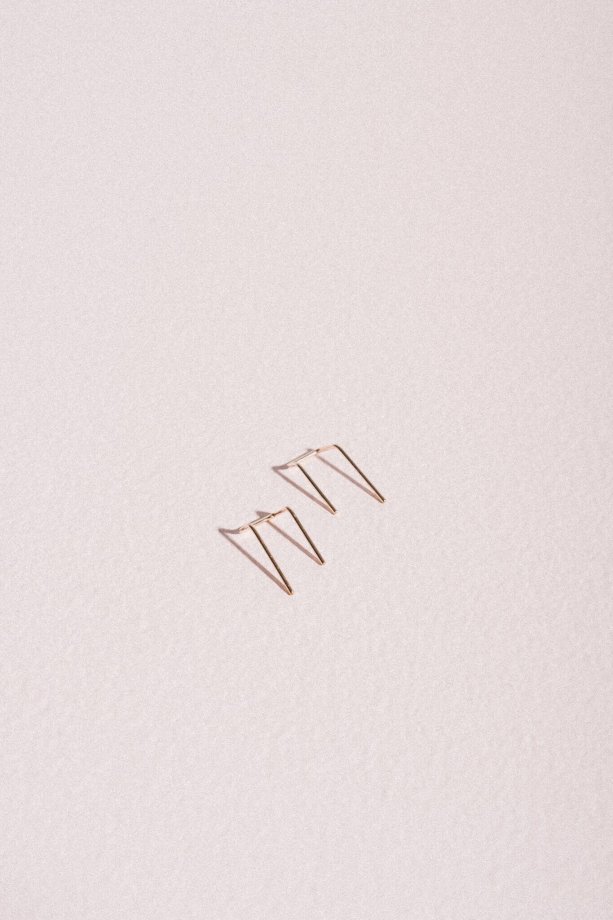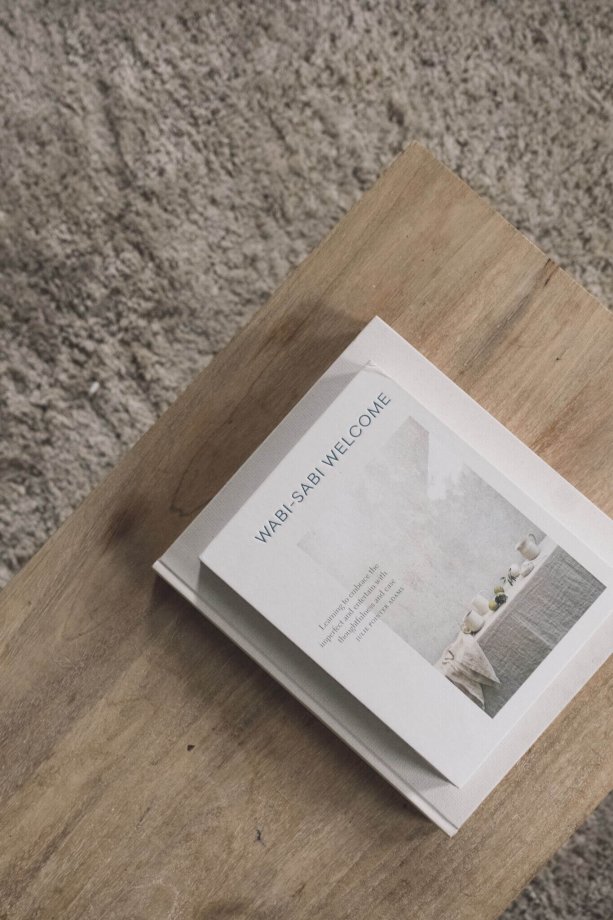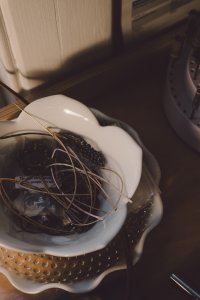To Become: The Self-Actualization of Nashville Jewelry Designer Blaque Reily
Jewelry designer Blaque Reily’s circuitous route to Nashville began when she was growing up, in her words, “an Alaskan hippie child,” with parents who fought to sustain a livelihood as entrepreneurs and artists in the small town of Ester, Alaska.“The registration between subjectivity and our humanity as individuals is at the core of my practice,” her mother, Sheryl Maree Reily, writes on her photography website. It features a series of Polaroid portraits, and one is a black-and-white image of Reily from years ago. Her mother captures her with poise and polish alongside a visible vulnerability.She still carries the memory of her home in rural Alaska, where she spent summers as a deckhand for the family’s commercial salmon fishing business and occasionally assisting with her parents’ photography.The memory is still there when she walks the streets of Nashville—the bustling city thousands of miles away where she runs her jewelry line. Reily has dubbed it Portmanteau Jewelry Collection. The term ‘portmanteau,’ originally coined by author Lewis Carroll, embraces the extended meaning present when two words or concepts are combined. To explain, Reily cites cultural examples: “spork” and “Brangelina.”A creative and maker at heart, she completed her MBA at Vanderbilt in 2016, which is originally what brought her to Music City. “I’m learning how to relax,” she says. “The feedback I get from people in my life is that I don’t know how to totally turn off—which doesn’t mean I’m extremely productive all the time. I’m actually beginning to integrate Netflix into my life. There’s something to be said for really shutting down your brain—not needing to be efficient or productive.” What would later become her business began when she started making things for herself that she couldn’t find—like hoops combined with a chain earring, which she crafts by hammering dainty, flat pieces of metal that can be layered and repurposed. The transformation into a business was not premeditated.The mentality of reinvention is reflected in the sculptural, petite and classic pieces Reily labors over, with an Instagram feed that’s a mixture of polished jewelry photos, sketches, sepia-toned family photos and inspiration, which could be anything from a beautiful home interior to a picture of a lemon cut in half. It’s an exciting moment when she sees people wearing her pieces and they’ve been mixed, matched and restyled. “When that happens, I know that I’ve done something right,” she says. Since coming to Nashville, Reily has joined the exhilarating and exhausting community of artists in varying stages of realizing their dreams. “I love Nashville,” she says. “I’m grateful for what it has offered me. I think every city has a prime—a fun and exciting time to be a part of its growth. Like Austin and San Francisco, years ago. I’m getting to be at the right place at the right time when it comes to Nashville. It’s a really supportive community, it’s accessible, and there are a lot of resources.” She also lived in Colorado, and then on the West Coast for two summers, which further developed her love of nature, the physical environments of the ocean, desert and mountains. “I do miss that,” she says. “Climbing to the top of a mountain and smelling the really dry, fresh air.”A self-described overthinker, Reily has surrounded herself with other dynamo Nashville creatives, like her roommate, painter Celeste Greene. Her boyfriend, folk singer and songwriter Korby Lenker, is constantly focused on manifesting his dream into reality. “You need that—someone who can weather that reality,” she says. “He’s going directly for what he wants.” He played a show in Alaska when Reily was 16, where they met for the first time, and serendipitously reconnected later in their lives. Life through Reily’s lens accepts what is truthfully human—that no one is made up of only positive or negative traits, that conflicting perspectives can both be valid and that multiple routes can lead to what’s right. The aura of her wares asks us to sit in the uncomfortable space of ambiguity, outside of traditional compartmentalization. “I remember once I had a guy friend tell me, ‘You shouldn’t wear hoops. You’re not one of those girls.’” Today, not only does she wear them—she makes them. “That’s an example of a time when my mission became to never let anyone tell me what I should or should not be. I like to play with that line between combinations,” she says. “Just because I’m an outdoorsy girl doesn’t mean I can’t wear hoops.”After graduating from high school, she left home and studied environmental science at Colorado College, in Colorado Springs. “I knew I had to get out of Alaska. I wanted to go explore. I never saw myself going back, but I do miss it. People who choose to live in Alaska choose to live at the end of the road. They just don’t want to be bothered. They do their own thing.” Reily then worked in energy efficiency consulting while waiting tables, planning to pursue higher education in either law or business. Through observation, she noticed many creatives struggled to make their art financially viable. Whether working as an artist, painter, musician, photographer or maker, she continued to bear witness to the time-honored struggle of life as an artist, reasoning that business school could help her achieve a level of entrepreneurial savvy to aid creatives in their journeys.“I will say, I have seen some creatives who are excellent at business. And the way you get good at it is by doing it yourself. But I also saw a lot of nonprofits and creatives struggle because of the business side of things, and the bottom-line piece wasn’t really their strength,” she says. Around that time she began consistently working with metal and clay, holding on to the precious gift of inspiration when it would come. “Working with your hands is not cerebral, but it’s incredibly satisfying. When I was living in Colorado, I just started making jewelry and messing around,” she says. Ironically, it was while applying for business school that she created the first iteration of the line, built a website and even secured a wholesale account. The pieces have a bohemian, salt-of-the-earth quality to them, as Reily draws inspiration from Alaskan and Native-American influences, as well as the natural world. Her selected materials are gifts of the earth: metal, beads, feathers.“It didn’t seem practical just to do jewelry. And I wanted to be helpful to creatives. But I really started missing the act of making.” Over time she secured a few more wholesale accounts in Nashville. Piece by piece, she began realizing that perhaps living life as a maker could work, without triggering pre-existing, timeworn fears. “In a very practical sense, it was the financial stress of the freelance lifestyle. Years ago, my father took me on a father-daughter fishing trip, and he took some pictures of me for the photography business. I must have been about eight, and I was being fussy with him. I remember he told me, ‘This business is what puts food on the table.’ Growing up with that financial struggle—I felt the uncertainty,” she says. “I knew in that moment, my heart of hearts, at eight, that the business did put food on the table. It was a team effort to make it work.”Halfway through her MBA, she felt something shift from within. It wasn’t a moment, but rather the culmination of a succession of moments that pointed somewhere other than where she was going. “I just knew I was headed in a direction that didn’t serve me,” she puts it. Her mother passed along a vital piece of advice, which affirmed her decision to choose a life outside of business school and pursue the jewelry business. She asked Reily, “Are you sure you don’t actually want to be an artist yourself?” In her own life, Reily’s mother had observed the truth that, “Often people put themselves as close to the thing they want as they can, without actually asking for it for themselves.”Once Reily got the design and basics down, creating enough jewelry to maintain inventory becamemeditative. Though learning the craft didn’t come from picking up materials and immediately creating beautiful pieces, it was selecting the right design solution from thousands of possible options that posed the largest challenge. “You have to go through this painful period where sometimes you’re very inspired, and then you run into something that doesn’t work,” she says. It was through trial and error that she also discovered some of her best pieces were the direct result of a former mistake. Recently she was asked by a curious bystander about her process, and how she uses her time when making pieces. One might assume that she spends most of her time in the ideation phase, but it’s actually sitting down with the materials and getting to know them.Very rarely does something transform from idea to reality without evolving, either due to an engineering problem or because Reily comes up with a new idea as she’s making it.Since shifting her focus to running Portmanteau, Reily has had more time to reflect on her process and journey than usual—or, perhaps it’s been happening in small bursts along the way. “I had a year where it became clear that I couldn’t be precious about what I actually wanted,” she says. And now, busily at work on her second collection, she plans to release each piece one at a time. She’ll also be doing a collaboration with Nashville-based luxury clothing line Ona Rex, which will be available spring of 2018.“Ten years ago, I felt very sure that I didn’t want to mix my creativity and my livelihood, because it would cost too much. But the life I’ve had in between has taught me that I am willing to do that. Because it’s worth it.” This story originally appeared in ALIVE Issue 6, 2017. Purchase Issue 6 and become an ALIVE subscriber.Photography by Attilio D’Agostino.












